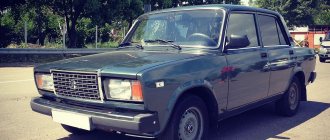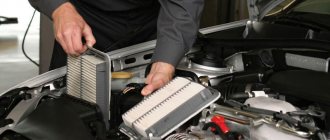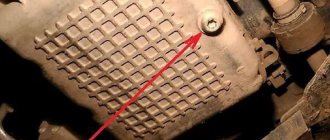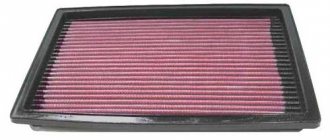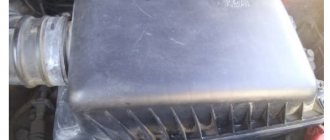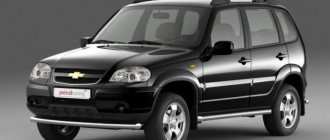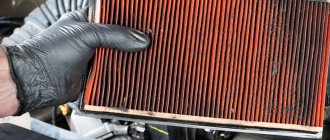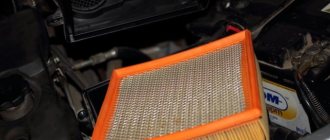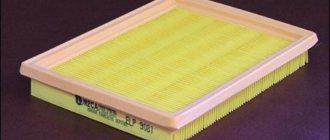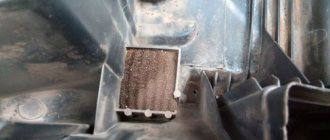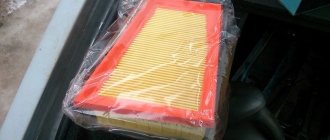Dirty air filter. What it affects, detailed symptoms and consequences
A car engine runs on an air-fuel mixture, which consists of gasoline and air - exactly two components, and not one, as many of us think.
If we pour the first component into the tank, and it is supplied through special channels (fuel system), then the second is sucked in directly from the environment, through a special air filter. Ideally, the filters should always be clean, so they supply the maximum amount of air to the cylinders, but over time it becomes dirty (simply clogged with dust and other “charms” - fluff, flies, etc.). Some owners don’t pay any attention to this - BUT IT’S NOTHING! Only then they gasp, why the power has decreased, the fuel consumption has increased... Despite the simplicity of its structure, the air filter plays a really important role - it does not allow dust and other dirt into the engine cylinders, in rare cases it does not allow water inside, that is, it protects the engine from water hammer.
Step-by-step instructions for replacing the air filter on injection engines
- Before you begin the procedure for replacing the air filter, purchase a new cleaning element, and stock up on tools with a Phillips screwdriver.
- Place the car on a level surface and raise the handbrake lever. Engage first gear (on a manual transmission) or park (on an automatic transmission) and turn off the ignition.
- Lift the hood cover and secure it with the stop.
- Disconnect the power plug from the mass air flow sensor.
- Then unscrew the 4 screws that secure the top cover of the case. If the casing cover is held on by clips, then simply snap them off one by one.
- Next, lift the lid and remove the old filter.
- After this, carefully wipe off the dust inside the casing and only now install a new filter. Please note that the filter fins must be directed in the direction of travel of the vehicle.
- Reassemble everything in reverse order.
Why is dust and other deposits so dangerous?
It's simple - dust can often consist of small particles of sand, at high temperatures they can begin to melt, in fact, turn into glass - this glass will settle anywhere and everywhere, for example on valves (both inlet and outlet), because of this work will be disrupted - compression will begin to drop.
As I wrote above, in extreme cases the filter will also catch water and prevent it from getting inside. However, you need to understand that he will only catch a small amount of water, but if there is a lot of it, there is actually a flood, he will not be able to stop it. So if your car is drowned, it needs to be properly dried - this is important!
Cons of air filters
YES, let’s talk about the disadvantages right away, at the top we described how wonderful this device is, how it protects and allows the engine to work longer, but it also has a negative point, although often there is only one.
This reduction in power means that the air that is sucked in encounters an obstacle in its path that it must overcome. More precisely, the engine must suck in air with force. To be honest, the filter is the culprit for the increase in consumption. If you compare the operation of the engine without it, then fuel consumption will drop by about 3 - 5% than with it. You have to pay for everything, although now there are options for zero resistance, but more on that later.
How often should you perform maintenance and change the air filter?
Economical fuel consumption can only be achieved by taking comprehensive measures to maintain your car in good technical condition. Regular vehicle inspection should be carried out no less frequently than when the vehicle has driven 8-10 thousand km. Change the air filter at the same intervals.
For example, if you use a clogged Kia engine air filter, fuel consumption increases by 10-20%. If this problem is not given enough attention, it will worsen over time and the engine will begin to consume even more fuel.
When operating a car in conditions of excessively high humidity and dust, it is worth carrying out maintenance and replacing the air filter every 5-7.5 thousand kilometers.
The advantages of such actions are clear to every motorist - by providing the car engine with a flow of clean air, you can not only reduce fuel consumption, but also prevent breakdowns.
Dirty filter - symptoms
Now we’ve come to the most interesting part: what will happen if we don’t change it? That is, it is overgrown with mud, and we ride and ride on it, say, 30 - 50,000 kilometers! It’s very simple - from the information I said just above, it follows that the filter element is simply an obstacle to the air and when the piston goes down, it must suck it in with force! But now imagine - it’s dirty, it allows air to pass through even worse, sometimes 2-3 times, its area is clogged with dirt, fluff, midges, etc.
The engine must spend much more energy to overcome this resistance, so the symptoms here are:
Just imagine this is an ordinary filter element, which essentially costs a penny.
What should you pay attention to?
The purpose of the air filter device is to clean the air entering the car engine from small particles of dust, soot, plants, insects, and so on. All these elements can damage the internal parts of the motor.
A good air filter should combine the following parameters:
- Bandwidth. Combustion of the fuel mixture inside the engine is possible if there is the required volume of incoming air. If the filter does not provide the required amount of air mixture, the combustion process of the fuel liquid is disrupted.
- Persistence. The material used for filtration should not be torn or cut into small particles.
- Porosity. The pores of the filter material must prevent the passage of small harmful particles of dust, spores, plants, etc., while ensuring the supply of the required volume of air, depending on the design features of the engine. Purchasing a filter material with the wrong pore size reduces the quality of filtration; instead of 98%, you can get 75%; large particles will get into the engine and damage the internal elements of the car engine.
- Airflow resistance. The filter serves as a kind of barrier to the air sucked in by the engine; the engine has to expend force to overcome the resistance it creates. The filter must be correctly selected so that the additional effort expended by the power unit is minimal and does not interfere with its operation.
Using a filtration element with inappropriate parameters leads to disruption of the motor, which reduces its service life several times.
We recommend watching a video about the consequences of using a clogged filter element:
Is it possible to clean the old one?
You know, there are many craftsmen who clean filters. Some even wash them in FAIRY, then dry them and use them again! If it’s even, then to put it mildly, I don’t understand such savings, well, you don’t have 1500 rubles (maximum price) for a new original one, well, buy a non-original one (you can do it here), it will cost 200 - 300 rubles, but it will be new, not “dirty” . This is right, do exactly this - you will win more money for the same expense, believe my experience.
So cleaning an old filter element is the same as using dirty toilet paper, about the same. In principle it is possible, but there is no need.
In conclusion, I want to say that now, in principle, there are filters with zero resistance, they do not block the air flow at all, that is, they are like a panacea, but many manufacturers are in no hurry to install them and there are a number of reasons for this, we will talk about this in the next article.
As for the standard ones, I gave you information today, change them with every oil change, and your engine will last many thousands of kilometers.
Now there's a terrible video, let's watch it.
Did you like the article? Subscribe to the channel to stay up to date with the most interesting materials
Source
Signs of a dirty air filter
Signs of a dirty (clogged) air filter
A car's air filter cleans the air entering the engine cylinders. Signs of a clogged air filter include engine misfires, noise, and increased fuel consumption.
A little theory - an internal combustion engine runs on a fuel-air mixture entering the cylinders. Air is supplied to the intake manifold through an air filter, the main task of which is to clean the incoming air from any solid particles (dust, sand, wood chips, etc.) that could damage the engine. Therefore, the air filter must have two important properties: on the one hand, it must reliably clean the air, on the other hand, it must have maximum throughput. After all, the more air enters the engine, the better - more power, less fuel consumption. Over time, the air filter becomes dirty and stops passing the required amount of air into the engine; an analogy can be drawn with a vacuum cleaner whose filter is clogged.
Most automakers recommend replacing the air filter every 10,000 to 20,000 kilometers or every 12 months. However, if you drive your vehicle in dusty or rural areas, it is best to have your mechanic check and change it more frequently, such as every 5,000 kilometers. Driving in a city with heavy traffic, where there are many frequent trips over short distances, and traffic jams also requires changing the filter more often.
Pay attention to the symptoms that indicate the need to replace the air filter:
Increased fuel consumption
To obtain the required power, the engine control unit compensates for the lack of air by increasing the fuel supply. If you notice that your fuel consumption has increased, it may be a sign that the air filter is clogged and needs to be replaced. However, this is clearly evident in cars with a carburetor. On modern cars, a clogged air filter does not dramatically affect fuel consumption; it will not increase by 2-3 liters as is the case with a carburetor. P0171 or P0172 is more likely to occur.
Misfire
Insufficient air supply due to a clogged air filter leads to the fact that the fuel does not burn completely and soot appears, which accumulates on the spark plug, preventing it from providing the necessary spark to burn the air-fuel mixture. The engine may start harder, stall, or run jerkily.
Unusual engine sounds
Check Engine Light Is On
Many modern engines consume about 10,000 liters of air for every liter of fuel consumed. Insufficient air supply can lead to an error in the control unit and, accordingly, the “Check Engine” . If this happens, it would be a good idea to check the air filter, among other things.
Air filter looks dirty
A clean air filter looks clean. It may be of different colors - white, yellow, green, etc., but it looks clean. As it collects dust and dirt, it begins to look dark. However, very often, the inner layers of the air filter filter paper can become clogged with dust and particulates that are not visible even in bright light. Therefore, be sure to follow the manufacturer's instructions regarding when to replace the air filter.
Engine power loss
If your car does not respond adequately to the gas pedal or you notice a jerky motion when accelerating, it may mean that the engine is not getting enough air. Replacing the air filter can improve acceleration and power by up to 11%.
Black, smoky exhaust
Insufficient air supply leads to the fact that some of the fuel does not burn completely. This unburned fuel exits the vehicle through the exhaust pipe. If you see black smoke coming from the exhaust pipe, have your mechanic replace or clean the air filter. You may also hear popping sounds or see flames at the end of the exhaust pipe. This is a potentially dangerous condition that needs to be corrected as soon as possible.
Smell of gasoline when starting the car
If, when starting the car, not enough oxygen enters the engine, unburned fuel ends up in the exhaust pipe. That's when you'll smell gasoline and know it's time to replace your clogged air filter.
Source
Symptoms of a problem
The mass air flow sensor is located in the air duct near the air filter. It is designed to determine the amount of incoming air. Depending on its readings, the control unit will show how much fuel is needed to form a high-quality fuel mixture. The normal ratio is 1:14. Therefore, the quality of the fuel-air mixture depends on the correct readings of the flow meter.
The high-quality operation of the mass air flow sensor depends largely on the cleanliness of the air filter. Therefore, if symptoms of a malfunction of the mass air flow sensor appear, you should first check the air filter before making repairs. The flow meter is usually beyond repair. If it is faulty, it is replaced with a new device. But its cost is quite high, so you should first make sure that the causes of the problems are in the sensor and not in other malfunctions of the machine.
The signal for diagnosis is the following symptoms of a malfunction of the mass air flow sensor:
- Check Engine appears on the instrument panel;
- an error is displayed indicating a low level of the mass air flow sensor signal;
- the engine is bad, accelerates very slowly, stalls, its power drops;
- high level of fuel consumption;
- the engine is unstable at idle;
- the engine stalls when changing gears;
- The rpms are either high or low.
There are other symptoms of a “dying” sensor. For example, it may have cracks in the corrugated hose that connects the throttle body to the sensor. If the engine stalls, there may be a power problem or damaged wiring. This is a signal to check the electrical wiring. If malfunctions are detected, the machine's electrical system must be repaired.
In addition to the above possible signs of failure of the mass air flow sensor, you should diagnose the sensor signal level.
A low signal level may mean the following:
- Mass air flow sensor is not connected;
Disconnected sensor connector
- open circuit in the sensor connection circuit;
- the mass in the chain breaks, oxidation appears;
- signal wires are broken or incorrectly connected;
- Engine control unit malfunction.
You should not draw conclusions about a malfunction of the mass air flow sensor, relying only on the symptoms listed above. A complete diagnosis of the engine and machine should be carried out, since signs of a flow meter failure may appear if other devices malfunction (for example, due to a clogged air filter). Then you need to repair these devices to restore the car's functionality.
DMRV error code
The following errors may indicate a malfunction in the operation of the mass air flow sensor:
- P0100 - damage to the electrical circuit connecting the sensor. To eliminate the breakdown, you need to check the wiring for integrity, since accidental disconnection of the connector or damage to the electrical contacts is possible.
- P0102 - the vehicle control unit began to receive a low signal, which was recorded at the input of the mass air flow sensor power line. To eliminate the cause of the breakdown, it is necessary to check the electrical wiring and the insulating layer of the cable; oxidation of the contacts of the wiring connector (the so-called chips) is possible.
- P0103 - critically high signal detected at the input of the mass air flow sensor power line. If the cause of the malfunction is not the wiring, then a visual inspection and cleaning of the flow meter will be required or it will have to be replaced with a new one.
Dirty air filter. What it affects, detailed symptoms and consequences
A car engine runs on an air-fuel mixture, which consists of gasoline and air - exactly two components, and not one, as many of us think. If we pour the first component into the tank, and it is supplied through special channels (fuel system), then the second is sucked in directly from the environment, through a special air filter. Ideally, the filters should always be clean, so they supply the maximum amount of air to the cylinders, but over time it becomes dirty (simply clogged with dust and other “charms” - fluff, flies, etc.). Some owners don’t pay any attention to this - BUT IT’S NOTHING! Only then they gasp, why the power has decreased, the fuel consumption has increased...
THE CONTENT OF THE ARTICLE
Despite the simplicity of its structure, the air filter plays a really important role - it does not allow dust and other dirt into the engine cylinders, and in rare cases it does not allow water inside, that is, it protects the engine from water hammer.
Air filters "DIFA" - high quality at competitive prices
When you replace the air filter, you should pay attention to the manufacturer of this device. By purchasing high-quality filter elements, you protect your car engine from premature wear.
DIFA-AVK LLC has been supplying filters for cars and trucks for more than five years and is the official distributor of the famous Belarusian company. These filter devices are very popular in Russia and the CIS countries. Thanks to the use of modern technologies, DIFA air filters are capable of eliminating up to 99% of contaminants, providing reliable engine protection. These devices are certified ISO/TS16949.
We offer a large selection of filters for any brand of car at competitive prices. It is also possible to manufacture custom-made air filters.
Why is dust and other deposits so dangerous?
It's simple - dust can often consist of small particles of sand, at high temperatures they can begin to melt, in fact, turn into glass - this glass will settle anywhere and everywhere, for example on valves (both inlet and outlet), because of this work will be disrupted - compression will begin to drop. There will also be sediment on the cylinder walls and on the piston rings - and this will lead to rapid wear and destruction. In general, there is no need for dust inside, so air filters are installed that are designed to combat it.
As I wrote above, in extreme cases the filter will also catch water and prevent it from getting inside. However, you need to understand that he will only catch a small amount of water, but if there is a lot of it, there is actually a flood, he will not be able to stop it. So if your car is drowned, it needs to be properly dried - this is important!
Misconception
Many car owners, noticing the symptoms of a clogged air filter, remove the device, then clean it, wash it or blow it out. After these manipulations, the filter material has an impeccable appearance. Please note: the filter material has a certain operational period, which is determined by its mechanical properties. Using a cleaned filter can lead to its rupture or increase in porosity - this will negatively affect the operation of the car engine.
Considering that the cost of the air filter is small, and the replacement frequency is up to 50 thousand km. mileage, there is no need to clean the old unit. It is better to purchase a new one, since motor repairs (which are inevitable when using an unsuitable or low-quality filter to clean the air flow) are much more expensive.
Cons of air filters
YES, let’s talk about the disadvantages right away, at the top we described how wonderful this device is, how it protects and allows the engine to work longer, but it also has a negative point, although often there is only one.
This reduction in power means that the air that is sucked in encounters an obstacle in its path that it must overcome. More precisely, the engine must suck in air with force. To be honest, the filter is the culprit for the increase in consumption. If you compare the operation of the engine without it, then fuel consumption will drop by about 3 - 5% than with it. You have to pay for everything, although now there are options for zero resistance, but more on that later.
Dirty filter - symptoms
Now we’ve come to the most interesting part: what will happen if we don’t change it? That is, it is overgrown with mud, and we ride and ride on it, say, 30 - 50,000 kilometers! It’s very simple - from the information I said just above, it follows that the filter element is simply an obstacle to the air and when the piston goes down, it must suck it in with force! But now imagine - it’s dirty, it allows air to pass through even worse, sometimes 2-3 times, its area is clogged with dirt, fluff, midges, etc.
The engine must spend much more energy to overcome this resistance, so the symptoms here are:
Just imagine this is an ordinary filter element, which essentially costs a penny.
DIFA fuel filters
produces fuel filters for various vehicle models that are highly efficient. The devices have been tested on benches and during operation. For questions regarding wholesale purchases and partnerships, please contact us at the phone number listed on the website.
To form the air-fuel mixture, clean air must enter the combustion chamber. The conditions in which vehicles are operated are far from ideal. There is dust, dirt, combustion elements, midges and a lot of other debris in the air, which will get into the combustion chamber, clog the fuel system and otherwise harm the engine if it is not cleaned. To avoid such problems, an air filter is used. Air is sucked through it, and dirt settles on the filter, which should be changed periodically.
Is it possible to clean the old one?
You know, there are many craftsmen who clean filters. Some even wash them in FAIRY, then dry them and use them again! If it’s even, then to put it mildly, I don’t understand such savings, well, you don’t have 1500 rubles (maximum price) for a new original one, well, buy a non-original one (you can do it here), it will cost 200 - 300 rubles, but it will be new, not “dirty” . This is right, do exactly this - you will win more money for the same expense, believe my experience.
So cleaning an old filter element is the same as using dirty toilet paper, about the same. In principle it is possible, but there is no need.
In conclusion, I want to say that now, in principle, there are filters with zero resistance, they do not block the air flow at all, that is, they are like a panacea, but many manufacturers are in no hurry to install them and there are a number of reasons for this, we will talk about this in this article .
As for the standard ones, I gave you information today, change them with every oil change, and your engine will last many thousands of kilometers.
Now there's a terrible video, let's watch it.
Sincerely yours, AUTOBLOGGER.
(
23 votes, average: 4.43 out of 5)
Similar news
Boring the cylinder block. Why does the engine need it and can it be done?
To turn over or not to turn over the engine until the cut-off? Is it necessary to do this
Source
BMW 5 series Girl restores › Logbook › Air filter. They pierced the nose.
Hi all! Yesterday I changed the air filter on my Bandit. Also, there were some other changes to the car, which will be discussed a little later.
To be honest, I was hoping to see bats fly out when opening the air filter box, but nevertheless, everything turned out to be not as bad as I imagined (I saw a worse picture), for which I thank the former owner for this)))
While I was preparing for the process, I read a certain amount of general useful information about the design of air filters and the principle of their operation and service life. I would like to tell you a little about the materiel. Maybe someone will find this useful. Girls, move closer, guys - all the best, thank you for your attention, we can disperse)))))
So, what is an air filter and what does it come with?
An engine air filter is a paper, felt or other air-cleaning element that prevents dust and dirt particles from entering the air-fuel mixture preparation system.
Just like the oil and fuel filters, the air filter contributes to the stable and uninterrupted proper operation of the internal combustion engine. What is it for? First of all, the filter passes through itself the air needed by the engine, filtering out dust that, if it gets in, the engine stops working normally. Periodically replacing the engine air filter is a process that needs to be taken extremely seriously. This problem is especially relevant for most Russian motorists, since the level of pollution on domestic roads is much higher than in Europe. The principle of operation of the air filter:
basically, for 1 kilogram of fuel, the engine consumes 13-15 kilograms of air, the intake of which occurs outside the vehicle, and also regardless of weather conditions. Because of this, dust, small stones and parts of asphalt, moisture and other substances enter the engine. The filter is designed to clean the air entering the car engine from many harmful impurities.
Over time, with intensive use of the car, the air filter may become clogged with particles of dust or substances, which will significantly reduce the throughput and, accordingly, increase the load on the filter itself, which may become deformed. For normal engine operation, the frequency of replacing the air filter should be twice a year. If you are careless about replacing the air filter, harmful substances and impurities will bypass the clogged filter and enter directly into the engine, thereby significantly accelerating wear.
A few signs of a clogged air filter:
Your car is using more fuel than usual;
The car lost significant power; The level of CO2 in the exhaust is significantly increased. Most drivers do not attach importance to these facts and drag out the problem until the last, critical moment, however, experienced car enthusiasts, as well as the current regulations, confidently declare: The engine air filter must be changed (at least) once every six months.
Moreover, you can replace it yourself without contacting car services.
Some drivers, in a desire to save an extra penny, pull out and clean the old filter. Doing this is strictly prohibited
, since the resource of each filter is limited and, despite its clean appearance, it will not bring any benefit to the car. That is why replacement is the most obvious and relevant option.
Types of air filters:
inertia-oil;
paper; zero resistance; multi-stage. Source
What happens if you drive a car without an air filter?
Running your vehicle without an air filter allows dirt, leaves, debris, bugs and a variety of air pollutants to enter.
These harmful elements cause significant damage to the internal parts of your car's engine, such as pistons, valves, and cylinders. In addition, your engine's fuel and oil consumption will increase significantly, which can lead to engine failure.
So, to keep your engine running safely and optimally, remember to promptly address the symptoms of a dirty air filter and always have a clean air filter in place.
Engine air filter clogged
Malfunction - the engine air filter is clogged (clogged), which is not uncommon on used cars.
It leads to a number of problems in its operation (see “How does a clogged air filter affect engine performance”). Using the example of the air filter of the carburetor engine 21083 of VAZ 21083, 21093, 21099 cars, we will try to find out its causes.
The engine 21083 of VAZ 21083, 21093, 21099 cars is equipped with a paper air filter that prevents dust and dirt from entering it. At the same time, the filter capacity is sufficient to ensure that the engine receives a certain volume of air necessary for its operation.
Signs of malfunction: “engine air filter is clogged”
— Difficulty starting a warm engine
A clogged engine air filter acts as another air damper for the carburetor. What does the damper have to do with it being closed? Which greatly enriches the fuel mixture at startup. And to start a warm engine, a rich mixture is not needed.
— Engine malfunction at idle
An insufficient amount of air entering through the air filter does not allow preparing the optimal composition of the fuel mixture for operation in idle mode. The engine “troubles”, jerks and tries to stall. If crankcase gases, carrying particles of engine oil, break into the engine housing, the situation becomes completely critical.
— Reduced power and throttle response of the car engine
With a clogged air filter, the car engine “suffocates” from lack of air. The composition of the fuel mixture does not correspond to power conditions (the mixture is too rich and refuses to burn efficiently). The engine loses power and throttle response.
— “Failure” when pressing the gas pedal
The already rich fuel mixture is further enriched when you press the gas pedal. The candles are flooded, the mixture does not burn well. A “failure” appears in the engine’s operation (or jerks - a series of failures).
— Increased fuel consumption
A clogged engine air filter does not allow the carburetor to prepare the optimal fuel mixture for each engine operating mode. The fuel mixture comes out constantly enriched. Fuel consumption increases depending on the degree of air filter clogging. Along the way, pops and (or) shots appear in the muffler, its exhaust pipe and spark plugs turn black, and the engine smokes.
Causes of clogged engine air filter
— Not replacing the air filter in a timely manner
The engine air filter must be replaced every 15,000 km of the vehicle. Up to this figure, it normally performs its filtering function and allows the required amount of air to enter the carburetor. After this, the blockage continues to increase, and the negative consequences (signs) of this blockage also appear progressively.
The situation can be aggravated by prolonged use of the vehicle in dust, dirt and off-road conditions. In this case, it is recommended to change the air filter more often.
— Clogged crankcase ventilation system
Gases from the engine crankcase are difficult to suck into the carburetor and air filter housing through a dirty crankcase ventilation system and oil separator. At the same time, the pressure in the crankcase increases greatly, causing oil particles to be intensively ejected into the filter housing, clogging the filter element and, at the same time, the carburetor jets.
Engine air filter housing oil
Step-by-step instructions for replacing the air filter on carburetor engines
- First of all, before replacing the air filter, purchase a new cleaning element, the same as that installed on your car. When searching for the required filter model, consult the car's operating manual or a spare parts store consultant.
- Place the car on a level surface and raise the handbrake lever. Engage first gear (on a manual transmission) or park (on an automatic transmission) and turn off the ignition.
- Lift the hood cover and secure it with the stop.
- Locate the air filter module. As a rule, it is located on top of the engine. Be careful, because if the car has just been driven, some components may be hot to the touch. On older car models with carburetor engines, the filter is usually located under a large, round cover made of metal or plastic. Newer models with a fuel injection system have a rectangular or square air filter housing, which can be found between the grille and the engine, slightly to the side of the center.
- Next, you should remove the air filter cover, after first loosening the clamp that secures the air duct. Unscrew all bolts securing the cleaning element cover. Various modifications of air filters have different fastenings. Some are secured with wing nuts, others are held in place with clips. Place the unscrewed screws and other small parts of the air filter in a safe place so that you won’t have to look for them for a long time. Pull the air duct cover up until it releases from the bottom of the chassis.
